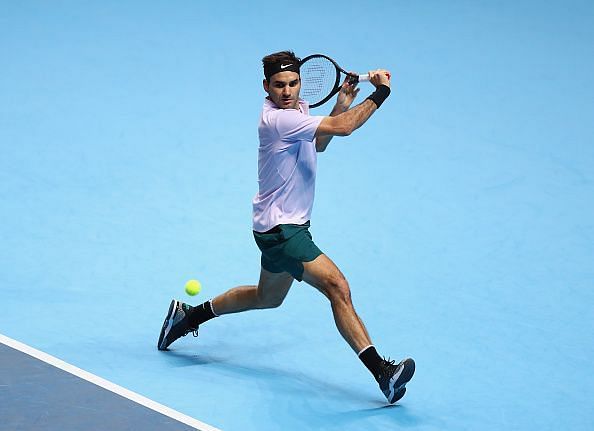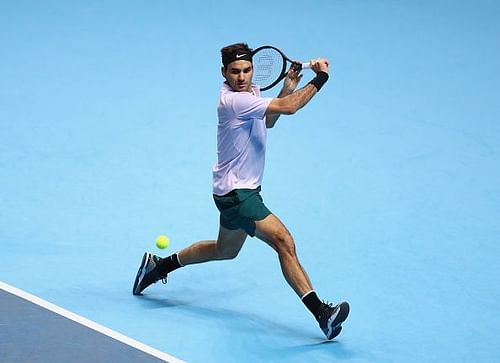
ATP Finals 2017 diary: The effortlessness of Roger Federer, viewed from close quarters

When you think of tennis in England, you think of old-world charm and long-standing traditions. But this very modern of tennis tournaments - the ATP Finals (the fact that its name changes nearly every second year should tell you how disconnected to the past it is) - is the exact opposite.
Unlike the decades-old Grand Slams, the Finals are held right in the heart of the city. You don't need an acres-wide arena on the outskirts to host an eight-player tournament; a snazzy mall-like stadium overlooking Canary Wharf will do just fine.
And the vibe around the O2 arena is different from the other tournaments too. With the London underground station leading right to the entrance gate, the streams of people filling into the stands are comprised more of suited up office-goers than picnic-attire-wearing families.
One word to describe the ATP Finals in London: businesslike. Funnily enough, I couldn't think of any other word to describe Roger Federer's play in his first two matches at the tournament.
Sure, he let out his fair share of 'Aiyaiyai!'s at missing routine shots, particularly in the second set against Alexander Zverev yesterday. But if I didn't know better, I'd say he was playing at a little less than full tilt, in a deliberate bid to conserve his energy.
The media seating at the O2 is slightly better than that at the Slams; you get to sit directly behind the players, which gives you a view that's very similar to that of a televised broadcast. Except that you get to understand and appreciate the depth and power of the players' shots a lot better than you can from the TV - call it the wonder of real life, if you will.
Throughout 2017, Federer has been standing closer to the baseline than he ever has, almost half-volleying some of his shots and softly caressing others. He's continued with that here, which makes sense since it's a fast indoor court. But yesterday was the first time I realized the full magnitude of just how impactful this style of play can be.
When he hits a wide serve in the deuce court, the reply invariably comes in the middle of the court. With modern ball-crushers like Zverev, that reply usually has plenty of pace and sting on it too, even off a first serve. But Federer being Federer, he never takes a step back; instead, while falling backwards, he just uses the pace of the ball to guide it into the open court, making the opponent scramble from one end to the other.
The backhand is similarly underpowered. While his follow-through gives the shot a very regal air, almost as if he's dismissing the ball from his sight, he almost never gives it an almighty whack. While Zverev kept smothering the ball into the ad corner, Federer kept taking it on the rise and re-directing it with slightly different angles.
This was aside from the mix of drop shots, slices, swing volleys (he hit one from close to the baseline yesterday) and forehand bunts which Federer always carries in his repertoire, and which always frustrates the living hell out of his opponents. Some of those tricks didn't work yesterday; in the game that he got broken back in the second set, he hit two ill-executed drop shots in succession. But for the most part they kept Zverev guessing, preventing the German from getting into a hitting rhythm.
Does any of this qualify as 'effortless'? In terms of sheer work required to generate power, probably yes; you don't exert as much muscle strength as the others if you play like Federer. But in terms of thinking on your feet and taking time away from your opponent through a chess-like approach to tennis, the Federer game requires plenty of effort - even if most of it is mental.
Mid-way through the second set I spotted Federer moving backwards to receive a second serve - the only time I saw him stand more than a foot behind the baseline for any return during the match. He managed to get a good topspin curl on his forehand return, but Zverev promptly sent it back with interest. Federer tried to scramble back into his usual hugging-the-baseline position, but it was too late; the point was gone from his grasp.
The Swiss never stood back to receive serve again. If anyone, including him, had any doubt about which style of play suits him best at the age of 36, that point should have made the answer clear.
The crowd, of course, loved every bit of it - playing style be damned. They hooted throatily for his winners, booed Zverev whenever he made a challenge, and in general looked ready to start a riot if Federer came close to losing - even if they were suited-up, stiff-upper-lipped Londoners. At one point a particularly raucous group of Federer supporters started singing "Let's go Roger!" to the tune of "Amazing Grace". The man is like a religious figure out here.
The three-set victory puts Federer into the ATP Finals semifinal for the 14th time out of 15 appearances, and the road seems likely to get easier from here. This isn't a Slam, where you battle lower-ranked opponents in the early going and face your arch-rivals towards the end; this is the bloody ATP Finals, where you run into a top 8 player right from the word go.
And it's one of the most unique Finals in recent memory too. Already shorn of Novak Djokovic, Andy Murray, Stan Wawrinka, Kei Nishikori and Milos Raonic, mostly due to injury, the 2017 Finals lineup is possibly the worst in the last decade. And when Rafael Nadal decided to withdraw after his loss to David Goffin, that seemed to be the last nail in the coffin.
The horribly cold and dark weather this week has probably added to the gloom surrouding the tournament too. But if Federer continues to play well, and continues to win, the crowd will forget all of that.
This may be the most foregone conclusion of a tournament I've ever attended, so it's probably just as well there's one man still standing who can effortlessly give people a reason to celebrate.